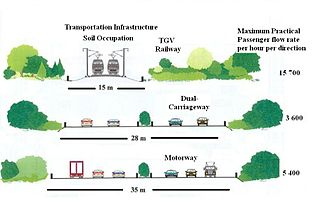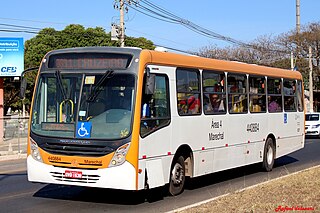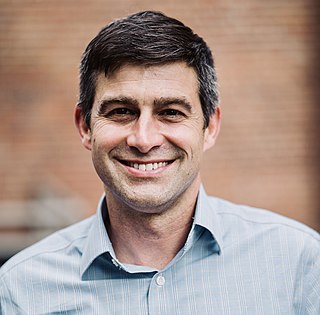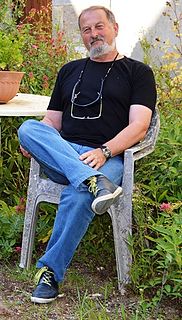Related Research Articles

A road is a linear way for the conveyance of traffic that typically has an improved surface for use by vehicles and pedestrians. Unlike streets, the primary function of roads is transportation.

Transport economics is a branch of economics founded in 1959 by American economist John R. Meyer that deals with the allocation of resources within the transport sector. It has strong links to civil engineering. Transport economics differs from some other branches of economics in that the assumption of a spaceless, instantaneous economy does not hold. People and goods flow over networks at certain speeds. Demands peak. Advance ticket purchase is often induced by lower fares. The networks themselves may or may not be competitive. A single trip may require the bundling of services provided by several firms, agencies and modes.

Bicycle-friendly policies and practices help some people feel more comfortable about traveling by bicycle with other traffic. The level of bicycle-friendliness of an environment can be influenced by many factors including town planning and cycling infrastructure decisions. A stigma towards people who ride bicycles and fear of cycling is a social construct that needs to be fully understood when promoting a bicycle friendly culture.

In urban planning, architecture, landscape architecture, and civil engineering, the term built environment, or built world, refers to the human-made environment that provides the setting for human activity, including homes, buildings, zoning, streets, sidewalks, open spaces, transportation options, and more. It is defined as "the human-made space in which people live, work and recreate on a day-to-day basis."

Sustainable urban infrastructure expands on the concept of urban infrastructure by adding the sustainability element with the expectation of improved and more resilient urban development. In the construction and physical and organizational structures that enable cities to function, sustainability also aims to meet the needs of the present generation without compromising the capabilities of the future generations.
William Louis Garrison (1924-2015) was an American geographer, transportation analyst and professor at the University of California, Berkeley. While at the Department of Geography, University of Washington in the 1950s, Garrison led the "quantitative revolution" in geography, which applied computers and statistics to the study of spatial problems. As such, he was one of the founders of regional science. Many of his students went on to become noted professors themselves, including: Brian Berry, Ronald Boyce, Duane Marble, Richard Morrill, John Nystuen, William Bunge, Michael Dacey, Arthur Getis, and Waldo Tobler. His transportation work focused on innovation, the deployment of modes and logistic curves, alternative vehicles and the future of the car.
Public transport planning or transit planning is the spatial planning professional discipline responsible for developing public transport systems. It is a hybrid discipline involving aspects of transport engineering and traditional urban planning. Indeed, many transit planners find themselves involved in discourse with urban-land-use issues such as transit-oriented development.
Transportation forecasting is the attempt of estimating the number of vehicles or people that will use a specific transportation facility in the future. For instance, a forecast may estimate the number of vehicles on a planned road or bridge, the ridership on a railway line, the number of passengers visiting an airport, or the number of ships calling on a seaport. Traffic forecasting begins with the collection of data on current traffic. This traffic data is combined with other known data, such as population, employment, trip rates, travel costs, etc., to develop a traffic demand model for the current situation. Feeding it with predicted data for population, employment, etc. results in estimates of future traffic, typically estimated for each segment of the transportation infrastructure in question, e.g., for each roadway segment or railway station. The current technologies facilitate the access to dynamic data, big data, etc., providing the opportunity to develop new algorithms to improve greatly the predictability and accuracy of the current estimations.

Active mobility, soft mobility, active travel, active transport or active transportation is the transport of people or goods, through non-motorized means, based around human physical activity. The best-known forms of active mobility are walking and cycling, though other modes include running, rowing, skateboarding, kick scooters and roller skates. Due to its prevalence, cycling is sometimes considered separately from the other forms of active mobility.

Public transport is a system of transport for passengers by group travel systems available for use by the general public unlike private transport, typically managed on a schedule, operated on established routes, and that charge a posted fee for each trip. There is no rigid definition; the Encyclopædia Britannica specifies that public transportation is within urban areas, and air travel is often not thought of when discussing public transport—dictionaries use wording like "buses, trains, etc.", and UK government COVID-19 guidance lists operators with no mention of air travel.
The Journal of Transport and Land Use is an open access peer-reviewed academic journal covering the interaction of transport and land use that was established in 2008. As of August 2011, it is the official journal of the World Society for Transport and Land Use Research. It is operated on a volunteer basis with institutional support from the Center for Transportation Studies and the Networks, Economics, and Urban Systems Research Group at the University of Minnesota, where it is published three times per year. The editor-in-chief is David M. Levinson.

Urban planning, also known as regional planning, town planning, city planning, or rural planning, is a technical and political process that is focused on the development and design of land use and the built environment, including air, water, and the infrastructure passing into and out of urban areas, such as transportation, communications, and distribution networks and their accessibility. Traditionally, urban planning followed a top-down approach in master planning the physical layout of human settlements. The primary concern was the public welfare, which included considerations of efficiency, sanitation, protection and use of the environment, as well as effects of the master plans on the social and economic activities. Over time, urban planning has adopted a focus on the social and environmental bottom-lines that focus on planning as a tool to improve the health and well-being of people while maintaining sustainability standards. Sustainable development was added as one of the main goals of all planning endeavors in the late 20th century when the detrimental economic and the environmental impacts of the previous models of planning had become apparent. Similarly, in the early 21st century, Jane Jacob's writings on legal and political perspectives to emphasize the interests of residents, businesses and communities effectively influenced urban planners to take into broader consideration of resident experiences and needs while planning.

William Warren Riggs or "Billy" Riggs is an author, city planner, entrepreneur and professor of Management at University of San Francisco, and an international expert in the areas of sustainable transport, technology, urban development and the future of cities. He is the author of the book, End of the Road: Reimagining the Street as the Heart of the City and Disruptive Transport: Driverless Cars, Transport Innovation and the Sustainable City of Tomorrow. He has worked as a professional planner, in venture capital for Just Business and a strategic consultant for various technology firms and startups. He also has experience as a successful recording artist and music producer, having worked on award-winning projects with Frances England, Gabriel Riggs and Carlos Villarreal.

Bruce Appleyard is an American city planner and urban designer, theorist, consultant, academic, and author. He works as a Professor of City Planning for San Diego State University in the School of Public Affairs. He has authored articles in the emerging field of Livability Ethics. He is the son of Donald Appleyard, a British-born American urban and city planner.

Eliahu "Eli" Stern is a professor emeritus of geography and planning, in the department of geography & environmental development at Ben-Gurion University of the Negev, Israel, and former secretary of the IGU Commission of Applied Geography.
Stephen E. Levinson is a professor of Electrical and Computer Engineering at the University of Illinois at Urbana-Champaign (UIUC), leader of the Language Acquisition and Robotics Lab at UIUC, and a full-time faculty member of the Beckman Institute for Advanced Science and Technology at UIUC. He works on speech synthesis, acquisition and recognition and the development of anthropomorphic robots.

Robert Cervero is an author, consultant, and educator in sustainable transportation policy and planning. During his years as a faculty member in city and regional planning at the University of California, Berkeley, he gained recognition for his work in the sphere of urban transportation and land-use planning. His research has spanned the topics of induced demand, transit-oriented development (TOD), transit villages, paratransit, car sharing, and suburban growth.

In transport planning, accessibility refers to a measure of the ease of reaching destinations or activities distributed in space, e.g. around a city or country. Accessibility is generally associated with a place of origin. A place with "high accessibility" is one from which many destinations can be reached, or destinations can be reached with relative ease. "Low accessibility" implies that relatively few destinations can be reached for a given amount of time/effort/cost or that reaching destinations is more difficult or costly from that place.

Vincent Kaufmann is a Swiss sociologist specialized in mobility studies and urban sociology. He is a professor of sociology at EPFL and the head of the Laboratory of Urban Sociology at the School of Architecture, Civil and Environmental Engineering.
References
- ↑ "Staff Profile".
- ↑ "Experts@Minnesota, from Scopus". Archived from the original on 2013-09-29. Retrieved 2017-04-07.
- ↑ Google Scholar Citations
- ↑ Levinson, David (2008) Density and Dispersion: The Co-Development of Land use and Rail in London. ``Journal of Economic Geography 8(1) 55-57.
- ↑ http://WSTLUR.org/about World Society for Transport and Land Use Research
- ↑ Winners of the Charles M. Tiebout Prize in Regional Science
- ↑ "Past CUTC Award Recipients" (PDF). Archived from the original (PDF) on 2013-09-28. Retrieved 2013-09-26.